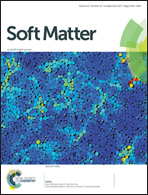Investigation on the function of nonionic surfactants during compressed CO2-mediated periodic mesoporous organosilica formation†
Abstract
A systematic study on the structural properties and component information of periodic mesoporous organosilicas synthesized by using different nonionic surfactants as templates with compressed CO2 was carried out. Triblock copolymers (F127, F108, and P123), oligomeric alkyl poly(ethylene oxide) (Brij-58 and Brij-76), and alkyl-phenol poly(ethylene oxide) (TX-100) have been employed as templates and BTEB as a bridged organosilica precursor to synthesize PMO materials at 5.90 MPa. The structure and morphology of the obtained materials were investigated by means of transmission electron microscopy (TEM), nitrogen sorption isotherms, solid Si and C NMR, and FTIR. Efforts have also been made to compare the differences in structural and morphological properties among these samples synthesized under similar conditions. We also investigate the synthesis of PMOs using F127 as the template at different CO2 pressures. It was found that the interaction between different organic silica precursors and surfactants with a variety of hydrophilic and hydrophobic chains is the key factor for the disorder degree of mesostructures. On this basis, the possible mechanism of formation of PMOs synthesized using a nonionic surfactant (triblock copolymer) as the template with compressed CO2 is illustrated and discussed.



 Please wait while we load your content...
Please wait while we load your content...